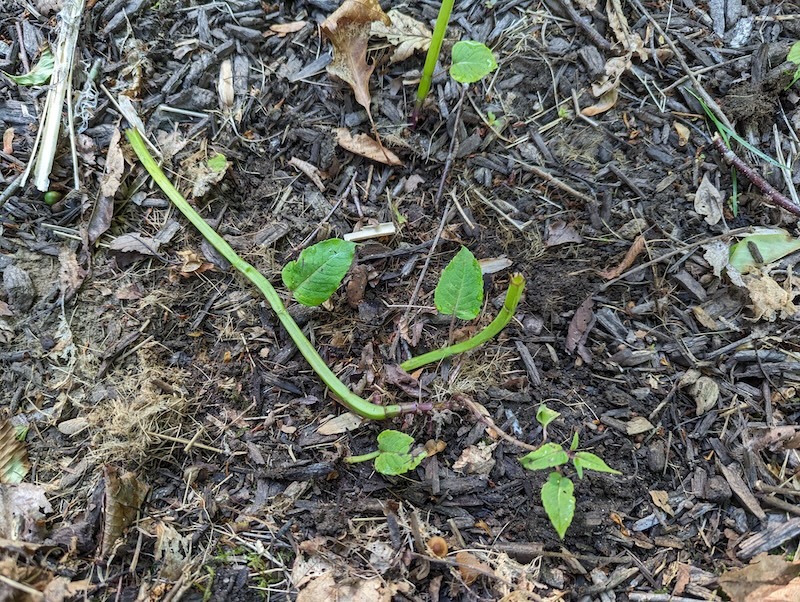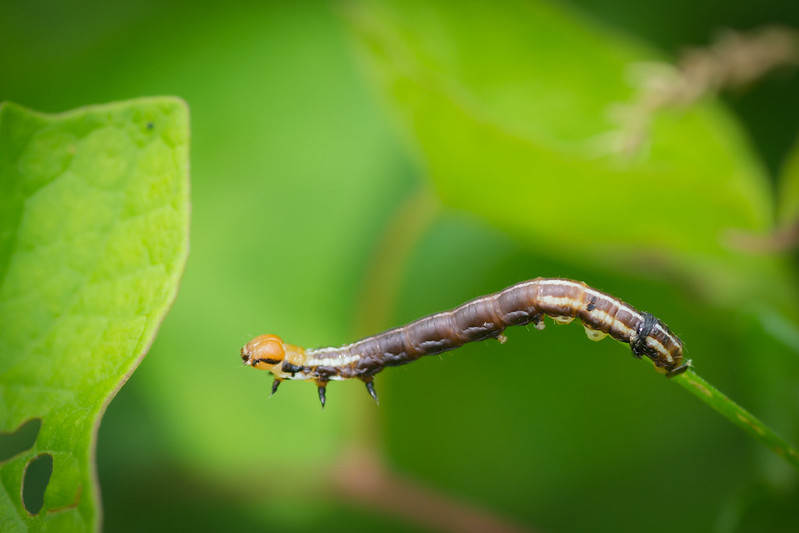Bee Balm is a fantastic perennial for planting in a pollinator-friendly garden design. The nonstop flowering supports a wide range of local and native bees. Fortunately, Bee Balm is only plagued by a handful of pests that are easy to control with some basic cultural methods. Aphids, spider mites, thrips, and stalk borer infestations can be cured with good garden hygiene and close monitoring of plants throughout the growing season.

Common Bee Balm Pests
Aphids
Aphids seem to appear from nowhere and can quickly multiply, sometimes creating secondary infestations of ants and sooty mold problems. A wide range of sap-sucking insects are called aphids and they come in many colors. The white aphids most commonly seen on bee balm strike when conditions are just right. Fast-growing, tender new foliage and flowers early in the summer are the main attractions for aphids. Stressed plants due to over or under-watering or lack of sunshine are more susceptible to infestation.
Aphids suck sap from leaves and stems while laying eggs for future generations near the base of the foliage and in the stem axils. As the aphid populations expand, their sticky excrement may become visible. Also known as honeydew, the excrement can attract ants who harvest the sweet honeydew. Aphid infestations can do serious damage to plants.
Treating Aphids on Bee Balm
Early aphid infestations can be easily controlled by removing any affected leaves or stems from the plant. A sharp stream of water from the hose can be used to wash the aphids off a plant. Make sure to spray both the top and bottom of the leaves and repeat as needed until no more damage or aphids are seen.
Care must be taken in applying chemicals because these treatments may harm local bee populations. Select insecticidal soap sprays approved by the OMRI (Organic Materials Research Institute) and apply them early or late in the day after the bees are done foraging for the day. Ensure that the product you choose is labeled as safe to use on bee balm, Monarda spp. Heavily infested plants should be removed entirely and disposed of in the trash or burned (if allowed in your community).
Preventing Aphids on Bee Balm
Grow bee balm in a location with full sun exposure (at least 6 hours) and well-draining soil. Avoid overly fertile sites or over-fertilizing bee balm with high nitrogen formulas; too much nitrogen promotes excessive foliage growth that is not well supported by the root system. The excess growth is generally the first to attract aphids to the garden. Instead of fertilizing, try mulching with organic compost in the spring to support healthy growth and flowering.
Attracting beneficial predatory insects will help to balance the ecosystem and keep future aphid populations in check. Providing places for lady beetles and lacewings to overwinter and lay eggs is the best way to encourage them to overwinter in the garden. Refraining from using broad-spectrum insecticides, and planting a wide variety of perennials and annuals will attract and sustain many species of helpful insects.
Spider Mites
Spider mites are another type of sap-sucking insect that tends to strike plants that are compromised in some way. The insects themselves are very small and often make themselves known by the damage they cause. Small spots all over the leaves and petals of bee balm indicate where the spider mites have been feeding.
During periods of low humidity, spider mites are most active. When levels of the mites get high enough, dense webbing in the leaf and stem joints will appear, eventually covering large parts of the plant. The constant feeding on foliage causes the plant's health to decline due to a reduced ability to photosynthesize and move nutrients where they are required in the plant.
Treating Spider Mites on Bee Balm
Spider mites can be managed in two ways. You can encourage beneficial predators such as lacewings, minute pirate bugs, and praying mantis to take up residence in the garden. These beneficial insects will keep spider mite populations to a minimum.
Second, insecticidal soap or NEEM oil sprays are effective in treating large outbreaks. Using sprays, even organically approved formulations, will affect any pollinators that depend on bee balm for nutrition. Use the sprays only very early in the day or late in the evening when pollinator activity is low to avoid harming local and native bees. Removing affected plant stems and leaves, especially as part of fall cleanup, will help to reduce future outbreaks by keeping the mites from overwintering on spent plant material.
Preventing Spider Mites on Bee Balm
Keep bee balm well watered during the flowering period and any long stretches of hot and dry weather. Plants that are stressed by dehydration are much more prone to attack. When conditions remain dry for an extended period, the use of oscillating sprinklers or a watering wand can be useful to wash off dust and give the plants increased, temporary humidity. Do this early in the day so that plants have plenty of time to fully dry before night to prevent any outbreaks of mildew or other fungal diseases. Regular monitoring of foliage and flowers is crucial to quickly treat spider mite infestations and keep them to a minimum.
Thrips
Thrips cause the same damage to foliage and flower petals as spider mites. The main difference is a lack of the telltale webbing that spider mites produce. Thrips are much more common on plants grown in greenhouses in crowded conditions where the mites spread from plant to plant.
The damage is mostly cosmetic and appears as stippling of the foliage and flower petals. If left to feed and multiply, thrips will damage plants by reducing the amount of nutrients available to the plant and impeding photosynthesis on heavily stippled leaves. Their excrement may be seen on the undersides as black specks. Thrips are also vectors for fungal diseases and viruses, and may transfer diseases to Bee balm such as powdery mildew.

Photo by James Baker, NC State University
Treating Thrips on Bee Balm
Removing damaged stems and foliage when an infestation is small. Plants that are heavily infested are best removed altogether and disposed of in the trash. Neem oil and insecticidal soaps are effective remedies but should be used only as a last resort. Select soap sprays that are safe for use on Monarda species, following the manufacturer's instructions. Spray in the early morning or late evening when beneficial pollinators are less active and less likely to be affected by the treatment.
Preventing thrips on Bee Balm
Encouraging beneficial predatory insects to visit your garden is the best way to keep populations of thrips low and in balance with the rest of your garden ecosystem. Lacewings, minute pirate bugs, and parasitic wasps in particular enjoy a good meal of thrips as well as many other insect pests. Let some parts of the garden stay wild to provide habitat for these overwintering bugs and their eggs. Clear weeds and grasses from garden beds where thrips overwinter.
Grow bee balm in full sun with minimal fertilization. Excessive flowering caused by overfertilization attracts thrips. Keep bee balm sufficiently watered during periods of lengthy drought or heat and deadhead plants if you do not intend to save the seed.
Stalk Borers
Stalk borers are often not noticed in plants until the whole plant literally collapses. The moth of the stalk borers lays eggs late in the summer either in the plant itself or in weeds around the flower garden. The eggs hatch into caterpillars early in the spring when they make their way to preferred plants.
As their name implies, the caterpillars burrow themselves in the stems and feed on the plant from the inside. The telltale holes with yellowing edges are easy to overlook but are the main clue to diagnosing an outbreak of stalk borers. Removing affected plant material and looking inside the stems will reveal dark-colored caterpillars and hollow stems.

Photo by Andrew Cannizzaro, unedited, Flickr, Copyright CC BY 2.0 DEED
Treating Stalk Borers on Bee Balm
Removal of the affected plant material is the only way to rid plants of stalk borers. The whole plant may need to be discarded if enough stems are affected. Burn or throw any dead or dying plant material away to also get rid of the caterpillars. Pruning the stem one or two inches below the entry hole may be successful if the hole is high up on the stem. Monitor for holes and yellow marks on stems early in the growing season to stop an outbreak as soon as possible.
Preventing Stalk Borers on Bee Balm
Preventing stalk borers is all about good garden hygiene. The moths like to lay eggs in weeds and grasses around the yard, so eliminating as many weeds as possible during fall and winter clean-up will reduce the number of eggs overwintering in the garden. Remove affected plant material quickly from the garden and do not add it to your home composting system. Burning the plant material is ideal, but if there are restrictions on burning in your community, dispose of it in the regular trash.
Bee Balm Pests Chart
|
Pest |
Identifying |
Treating |
|
Aphids |
Tiny, soft-bodied insects, typically green, yellow, brown, red, or black |
Wash off plants with a sharp spray of water from the hose |
|
Spider Mites |
Fine silk webbing on the undersides of leaves |
Use insecticidal soap or NEEM oil sprays |
|
Thrips |
Yellow, brown, or black and have fringed wings, which are narrow and pointed |
Remove damaged stems and foliage |
|
Stalk Borers |
Larvae of moths or beetles, brown or gray coloration |
Removal of the affected plant material |
Sources: "Beebalm (Monarda)." The Connecticut Agricultural Experiment Station. portal.ct.gov
 |
Author Robbin Small - Published 12-21-2023 |
